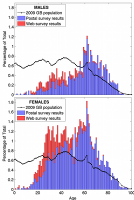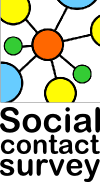Schools Contact Survey
We are undertaking a large-scale survey (and analysis of the results) in an attempt to understand patterns of human mixing. In turn this will lead to a better understanding of the numbers of contacts that could lead to the spread of infection, and therefore allow us to better predict (and therefore offer better advice for controlling) future epidemics. Further details can be found here.
|
The nation-wide contact survey was a huge success. We have had over 3000 people complete the paper version of the questionnaire, and a further 2000 complete the on-line version. Respondants have been from all occupations, from all over the UK, and even from many other countries. However, we have had very results from children (compare the black line to the colored bars in figure). To remidy this we are conducting on-line surveys through participating schools. This page is divided into two sections: Information for Parents and Notes for Teachers. We hope these will help you understand why your child may be taking part in this survey and will address any concerns that you may have. |
Information for Parents
The most important things to stress are that:
- Taking part in the survey is entirely voluntary. Your child can opt-out or simply stop filling in the survey at any point.
- All results are anomymous. Although we ask for names, these are not recorded. We ask for your child's name so that teachers can identify individual contact networks that are printed at school; we also ask for the names of contacts, simply so that we can ask further questions about each one. We will not identify individual children or schools in any scientific publications.
- Finally, the questionnaire and the entire process has undergone rigorous ethical approval.
The on-line survey has been designed to be easy (and hopefully fun) for any child to complete. They are led through a series of simple questions about themselves and their contacts; and before each question they are given a simple public-health or basic hygiene message to explain why this is important. At the end of the survey, your child can see a picture of their contact network which the school can then print. We hope that this will stimulate classroom discussion on a range of subjects from basic health and vaccination, to friendships and social activities, to mathematics and representing patterns.
There are 6 sets of questions that your child will be asked:
- About themselves. We ask and record: age, school name and number of people living in their house. We also ask for your child's name, but this information is never passed to our computers. (We ask about the number of people in the household as many infections are generally spread in the home.)
- List of Contacts. We ask the child to list all the people they have spoken to (had a close conversation with) yesterday. We do not store these names.
- Touch. For each contact we ask if the child touched this person or not. We ask this because many infections are passed very easy by holding-hands, hugging, kissing etc.
- Where. For each contact we ask the child to say if it happened at home, at school or elsewhere. This provides some context behind the connections.
- How Long For. Again for each contact we ask if it was short (less than 5 minutes), between 5 and 30 minutes, between 30 minutes and 1 hour or longer. Longer duration contacts are much more likely to be associated with the spread of infections.
- Who met whom. This is probably the hardest part of the survey. For each pair of contacts, we ask if these two people were likely to have met each other in the past week. This tells us about cliques and close friendships where infections can spread through multiple routes.
We really hope that you will support us in this work and allow your child to take part in the survey. If you would like to help, we have an on-line survey for adults that asks a very similar set of questions.
If you have any questions about this work, please feel free to email one of us.
Once your school has completed the survey, we hope to be able to provide you with some basic feed-back with a few weeks.
The survey.
The on-line survey is broken into 6 components, each of which first has a simple public-health (good hygiene) message, then some brief comments about how to fill in the questions, and then the questions themselves.
1) All about you
These questions allow us to understand more about the person, so that we can look at the impact of gender, age and household size. Although we ask for the child’s name (and use this if they print out their network), this information is not stored and cannot be recovered by us.
The only question that might arise is exactly what is meant by “how many people live in your house”. What we want to know is about people who spend the majority of nights in your house. If the child is unsure about this (ie dad works away etc) a best guess will be fine.
2) Who did you talk to?
This is the main part of the survey. We want each pupil to list all those people they had a conversation with – it must be a two-way close-proximity (ie less than 2 meters) conversation. So when a teacher talks to the entire school in assembly that does not count.
We will want the pupil to think back to the previous day and list all contacts – this is often easiest if they think of what they do during the day – from getting up in the morning to going to bed at night.
Although we ask for names, we don’t store this information – it is only so we can ask other questions on the following pages.
3) Did you touch?
Many infectious diseases are spread by very close contact, so it is important to know if we touched our contacts. We really only want to know about skin-on-skin contact (eg holding hands), pushing-and-shoving or bumping into each other does not count.
4) Where were you?
Context is often seen as important for disease spread; we would like to understand how much happens at home, at school and elsewhere. These are the three choices the pupils are given – they can select multiple values, for example if they see someone at home and at school. Note that home means the pupil’s home, if they go to someone else’s house that is elsewhere.
5) How long for?
Obviously the longer we spend with an infectious person, the greater the risk of catching the infection from them. So we would like the pupils to estimate the length of each contact. We have tried to relate the choice of times to school-day activities (such as whole lessons, break-time, etc). Experience has shown that this is the part that young pupils (and adults) have the most trouble with.
6) Who met who?
Who we meet is not random, but in general contacts are clustered – that is what we are trying to determine with this question.
For each possible pair of contacts, we ask if the two contacts have met each other in the past week. For some this is obvious (eg my sister met my mum) for others it is far more complex (eg did my sister meet my teacher). What we are looking for is best guesses. Pilot studies have shown that children are as good as adults as estimating this.
In general the important thing is that the children have fun completing this questionnaire. Small mistakes do not matter too much to our findings, so pupils should not worry about the details.
Public Health
The most important message to get through from this work is the importance of good hygiene – hand washing, using and binning tissues, and catching coughs .
Another thing that can be seen is that we are most likely to spread diseases to, and catch diseases from, those people we are close to – such as friends and family. (Although we all tend to associate catching infections with abnormal activity and strangers, this is rarely the case – most adults tend to catch infections from their children).
For older children it might be interesting to talk about vaccination, and the fact that we can be protected against many diseases. This is especially important with HPV (human papilomavirus) vaccines on offer to teenage girls to protect against cervical cancer. You could also discuss any scare-stories surrounding vaccines – noting that all vaccines used in the UK are rigorously tested and very safe.
You could also discuss the difference between infections (caused by germs like flu or colds) that spread from one person to another and other diseases (such as cancer) that are in part caused by life-style
Further work
The information that is collected in these questionnaires can be fed back to the school (if required). This leads to the potential to do lots of simple maths
- drawing bar-charts for the distribution of the number of contacts (the maximum number from our adult survey is 3000, the average is about 20)
- to looking at where most contacts occur (most will be at school, although longer contacts are often at home)
- creating a network of contacts within the classroom (put each child’s name on a big sheet and join up children who played together yesterday or spoken to each other etc etc)
- older children might be interested in the concept of “small-worlds”, and the fact that we are only about five social contacts away from anyone else in the world (the usual example is the US president).






